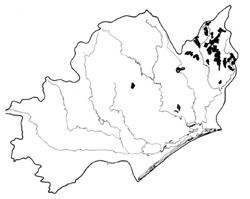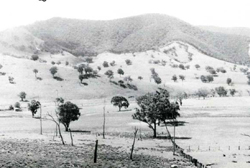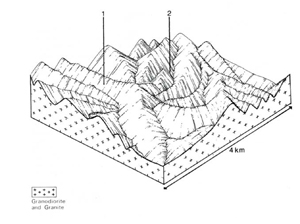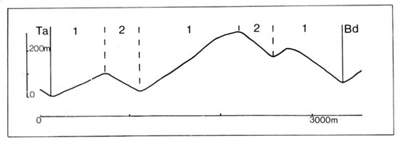Blomford (Bf)
 | Area: 318 sq. km (1.6%) Terrain within this land system is formed on granites. granodiorites, gneissic metamorphics and related coarsely-crystalline, plutonic rocks. Topography is mountainous, with long, steep slopes, rock outcrop and a ridge-and-ravine dissection pattern. In these respects Blomford is similar to Baldhead land system; however, Blomford is mapped in the much drier areas which occur mainly at lower elevations, and is more limited in extent. Small levees and alluvial flats (similar to Walnut land system but not mappable at 1:100,000 scale) occur occasionally along a few major streams, notably the Timbarra River. The Blomford land system has relatively slow rock weathering and high, natural erosion rates due to incomplete vegetative cover and steep slopes. This has resulted in shallow soils that are weakly aggregated or apedal throughout and moderately acidic. The vegetation is open forest I or II with sparse understoreys. |  The partly cleared steep slopes on the resistant metamorphics of Blomford land system are part of the metamorphic aureole surrounding the lower, more gentle slopes of Dargo land system which have formed on deeply weathered plutonic rocks. |
| CLIMATE Rainfall, mean (mm) Temperature, mean (°C) Seasonal growth limitations |
Annual 700 - 1200: lowest January or February (40 - 80), highest October (100 - 150) Annual 8 - 12: lowest July (3 - 7). highest February (16 - 20) Temperature <10°C (av.): April - October Rainfall < potential evapotranspiration: December - February; occasional winter snow |
| GEOLOGY Age, lithology |
Palaeozoic granites, granodiorites. gneissic metamorphics and related coarsely crystalline plutonic rocks |
| PHYSIOGRAPHY Landscape Elevation range (m) Relative relief (m) Drainage pattern Drainage density (km/km2) |
Steep mountains with ridge-and-ravine topography 220 - 920 80 - 400 Dendritic 0.5 |
| PRESENT LAND USE |
|
 |  |
| LAND COMPONENT Percentage of land system Diagnostic features | 1 85 Slopes with drier forest | 2 15 Slopes with moderately humid forest |
| PHYSIOGRAPHY Slope %, typical and (range) Slope shape | 30 - 50. (20 - 80) Straight | 40 - 50. (30 - 80) Straight |
| SOIL | ||
| Parent material | Granite. granodiorite and gneissic metamorphic rock | |
| Description | Dark greyish brown loam to loamy sand topsoil grading into brown and slightly reddish brown subsoil of variable texture (clay to sand): generally very stony and shallow | Dark greyish brown sandy loam topsoil grading into slightly reddish brown to yellowish brown subsoil of variable texture (sandy clay to coarse sand); generally stony but deeper than in component 1 |
| Classification | Lithosols Um1.23. Uc5.21. Gn3.21 | Lithosols Um5.51. Uc1.42. Uc5.21 |
| Surface texture | Loam to loamy sand | Sandy loam |
| Surface consistence | Slightly hard when dry | Soft to slightly hard when dry |
| Depth (m) | <1.0 | <1.2 |
| Nutrient status | Low to moderate | Low to moderate |
| Available soil water capacity | Low | Low to moderate |
| Perviousness to water | Rapid | Rapid |
| Drainage | Good | Good |
| Exposed stone (%) | <50 | <20 |
| Sampled profile number | - | - |
| NATIVE VEGETATION Structure of vegetation and characteristic species of dominant stratum (+ Predominant species) | Open forest I, II: E. macrorhyncha and/or E. sieberi generally predominant: E. goniocalyx, E. rubida and E. globoidea (less frequently) associated | Open forest II (denser understorey than in component I ): Mostly E. dives+, occasionally E. obliqua+; E. pauciflora (higher elevations). E. goniocalyx. E. globulus and E. cypellocarpa associated |
Disturbance | Affected process and trend | Primary resultant deterioration | Casual activities | Primary off-site process | ||
Form | Susceptibility of components | Incidence with components | ||||
— reduction in leaf area, rooting depth and/or perenniality — reduction in density of tree roots | Reduced transpiration, resulting in increased deep percolation and leaching Decreased root-binding | Nutrient loss Soil creep | 1,2: moderate 1; high | Not determined Uncommon: but isolated instances | Removal of trees Accelerated by any major disturbance of the native vegetation | Increased movement of water to groundwater: increased base-flow of streams Increased sediment load |
| Increased overland flow and soil detachment | Sheet and rill erosion | 1.2: high | Common | Clearing, logging, burning, overgrazing, road building and other earth-moving activities, trafficking by stock. | Increased flash flows and sediment load. |
| Increased compaction With reduced infiltration | Structure decline Sheet and rill erosion | 1,2: low 1.2: high | Uncommon Common | Increased trafficking and overgrazing As for sheet and rill erosion above | - Increased flash flows |
| Increased soil break-up | Gully erosion | 12: high | Uncommon | As for sheet and rill erosion above | Increased sediment load. |
| Comments: - | ||||||


